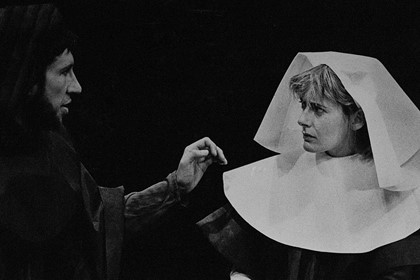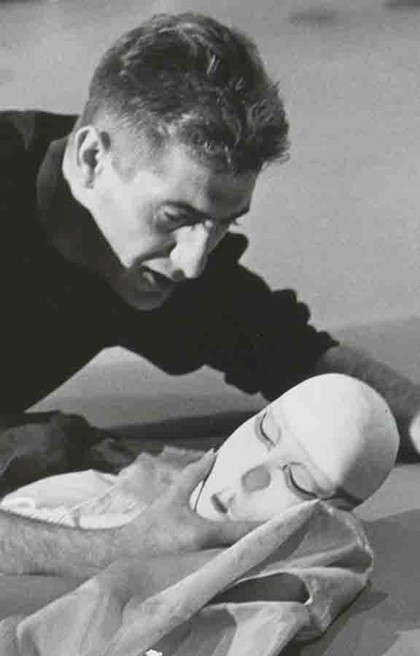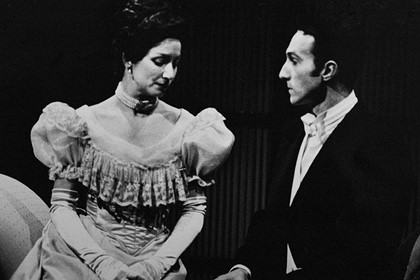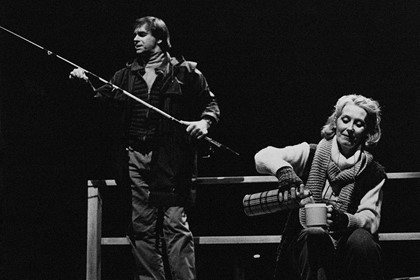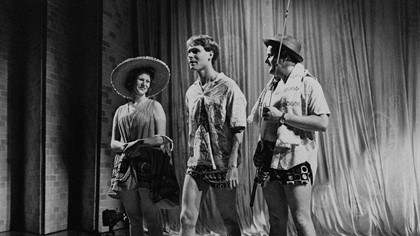1980 to 1990s
Now officially rebranded as Playbox and with a permanent base of operations, the company set about growing its national reputation, while continuing to explore new partnerships and models for what a contemporary Australian theatre company could look like. This early period would be dramatically impacted by a fire in 1984 which destroyed the Playbox Theatre building leaving the company to work out of venues around the city for six years.
The late 70s and early 80s were a fraught time for the company. The fledgling administrative team struggled with balancing the company’s finances against its artistic demands. Government funding was uneven and the company was still feeling its way around its artistic and programming objectives. The annual programs presented new Australian plays alongside contemporary international work, as well as productions of classics, and a children’s theatre program.
The pressure of overseeing the administration of the company, balancing the programming mix, directing and performing in the shows meant that the leadership of the company was constantly stretched to its capacity, and regularly running out of money. Gantner described these difficulties, telling The Age:
‘I think I’ve been harder than the average actor to work with in this informal situation … Although when we rehearse I always say I don’t want any calls or interruption, there are some problems which inevitably intrude. Something always happens, so I’m never quite able to make the complete transition from administrator to actor … In a little organization like ours, you are still quite close to the product as an administrator, but even so, unless you put your life on the line creatively from time to time, you tend to deaden a part of yourself.’
Some of this pressure was alleviated in 1979 with the appointment of Jill Smith as the company administrator, who would remain with the company through three artistic directors, two name changes, a major relocation, and more than 25 years of service. This year would also see the departure of Garrie Hutchison, pursuing other projects, and Graeme Blundell, who left the company to star in the box office smash hit Australian movie Alvin Purple.
In June 1981, the highly respected director Rex Cramphorn was appointed as Playbox’s resident director, with a special focus on developing actors and the actors’ process. This focus would become the legendary Actors Development Stream, a continuation of his pioneering work with the Performance Syndicate, an intensely collaborative actor’s ensemble based in the Old Tote Theatre, Sydney.
In the years that followed, Playbox struggled with establishing clear lines of authority within the company leadership structures. In early 1984, Gantner was offered the position of Cultural Attaché in Beijing, and so the Board began a search for a new Executive Director. This would result in the mid-year appointment of James McCaughey, a noted classicist and former director of the Mill Community Theatre in Geelong, as joint Executive Director with Jill Smith. McCaughey would also share some of the responsibility for setting Artistic Policy for the company with Cramphorn.
This somewhat awkward triumvirate power structure would only remain in place for a few months. Cramphorn resigned as Resident Director in November 1984. He would, however, continue to direct works with the Actors Development Stream into the following year, producing Hamlet and Measure for Measure in repertory, with both shows using the same cast.
The Fire
In the midst of all this, the Playbox Theatre on Exhibition Street was destroyed by fire. The fire broke out early in the morning of February 7, 1984, causing an estimated $300,000 worth of damage. The Downstairs theatre was completely gutted, and its seating, lighting and sound equipment were completely destroyed. Fortunately, however, though the Box office and Administration areas were waterlogged and blackened, they survived the fire along with the season subscription information. The fire was found to be deliberately lit, though no culprit was ever apprehended.
Journalist Anthony Clarke described talking to Gantner in the days after the fire, writing in The Age:
‘With the acrid stench of wet charcoal in our nostrils, Carillo Ganter, executive director of the Playbox Theatre in Exhibition Street, started to talk about the future. We had just walked through the fire-scarred foyer which had until early yesterday been dressed with Mirka Mora’s spirited mural. Mr Ganter had sat for photographers in the skeletal remains of the main auditorium. A door at the back of the stage let in sunlight, that light emphasized the darkness of the ruined theatre…. "Tell the people to keep subscribing to our season," he said. "We don’t know where the plays will be, but they’ll be on. And all our records are intact. We know exactly who has subscribed… And who hasn’t." On the back of a scorched 1984 season subscription brochure, he had pencilled the names of those who had rung to offer the Playbox aid.’
The loss of the company’s venue led to an extended period of itinerancy during which time the company presented works at venues across the city, including the Victorian Arts Centre (VAC), Dallas Brooks Hall and St Martins Theatre in South Yarra, while the search for a new home was ongoing.
Jo Litson, company publicist at the time wrote in the Playbox Progress newsletter that:
‘Robert Gebert rang me from Sydney where he was touring with Insignificance to find out if it was true. I leapt out of bed, still not believing it and ran all the way to the Playbox. From a distance all looked well, but Jill was standing outside in the rain in tears. That day was a nightmare, as were the following 2 months, when we worked from the charred box office – all 12 of us. Unable to tear ourselves away from the building, unable to overcome the misery because every smell, everything around us was a constant stabbing reminder. The stench was nauseating. We wore masks at work. I remember sitting in the burnt-out foyer – a black and cavernous hole, working on the mailing list by the light of a kerosene lamp…’
Gantner returned from Sydney, where he had been performing in the tour of Insignificance, to survey the damage and to oversee the search for a new venue and, on May 29th the Company announced the donation of the South Melbourne Malthouse by Carlton and United Breweries, valued at $2M, to act as a new home for Playbox. CUB also contributed a further $80,000 as the first major corporate donor to the building project and the State Government of Victoria committed to support Playbox’s move into The Malthouse with a three-year capital grant of $750,000. The company also received donations from the Sidney Myer Fund, Credit Union and The Potter Foundation.
At Gantner’s farewell dinner in 1993, former Board Director Graeme Samuels recalled of Gantner at the time of the fire that:
‘Carrillo was about to depart for China. Playbox now had neither a home nor any artistic direction although thankfully we still had Jill Smith. Carrillo could well have taken the position that as he was leaving to start a new life and career elsewhere, that it was up to the Board and his successor to deal will the theatre company’s venue. But that wasn’t his style. In the short period before he departed for China he worked, assiduously with Jill and members of the Board, to locate suitable alternative venues for the long-term home of playbox. And while he was away, he always accepted as a fact what was our constant hope: that he would return to Australia to once again take up the reigns of this theatre. And when he did return from China, he must have despaired somewhat, for Playbox was still without a home. Although it was the owner of an old Malthouse in south Melbourne, it had had the difficult seasons, and seemed to be lacking artistic direction. I guess it was probably Playbox’s lowest point in its history.’
In 1986 McCaughey resigned as Executive Director and the Board once again began the search for a replacement. In the middle of the year, Peter Oyston was announced as the new Artistic Director of the company.
During this incredibly complicated time for the company, and despite the difficulties of retaining subscribers without a central venue, and at the same time managing the extensive renovations required to turn the CUB Malthouse into a working theatre, Playbox continued to expand its engagement with the Asia Pacific regions. Partnering with the renowned Australian puppetry company, Handspan Theatre, to produce the massively successful production of Cho Cho San, written by Daniel Keene. Cho Cho San, an adaptation of Madame Butterfly, opened in Melbourne on February 9th and went on to tour nationally throughout 1987, and internationally to China in 1988 where it sold out its Beijing season.
In 1987 Playbox also presented Jack Hibberd’s A Stretch of the Imagination in Shanghai, translated into Mandarin. Directed by Carrillo Gantner, it starred local Chinese actor Wei Zong Wan in the role of Monk O’Neil, and had the distinction of being the first performance of an Australian play in China.
Transition to the CUB Malthouse
In November 1987 Gantner returned to Melbourne to oversee the transformation of the Malthouse building and was appointed Co-Artistic Director of Playbox with Oyston. This relationship was not without its tensions, as had been the relationship between Oyston and the Playbox Board of Management. Oyston’s vision for the company included a focus on Televised theatre productions, which the board showed no great enthusiasm for, and he remained more interested in directing than in the ongoing management of a theatre company. These tensions came to a head in late 1987, particularly focused around a planned production in London that he was to direct independent of the company, and ultimately resulted in Oyston’s decision to resign from the position in 1988.
During 1988 and 1989 Playbox began the transition out of its post fire itinerant phase, overseeing the renovations of the CUB Malting House, and moving into it as the company's permanent home.
John Ridge writes in Playbox at The CUB Malthouse, a pictorial history released to celebrate the opening of the new theatre, the 'impressive and highly atmospheric three storey red brick building had been built in 1892 for the Castlemaine Brewery Company.' Converting the space was no small task. Ridge describes how 'The greater part of the building was covered in an ugly cream kalsomine paint, extremely difficult to remove. In fact, it took three solid months of steam-cleaning to restore the pristine appearance of the brick, while the entire interior underwent a process of dust-blasting to get rid of the whitewash, kalsomine, and remnants of tar-paper lining.'
During this time the company also established some significant international relationships, not the least of which was with the world-renowned Japanese director Tadashi Suzuki, and began establishing plans for its major partnerships for the next decade.
On the 25th of September in 1987, the company announced a major partnership with Monash University, to begin in 1990. The company would become The Playbox Theatre Centre of Monash University, with a regular season of Playbox works being toured locally to the Alexander Theatre, and the creation of a position for Education officer within the company. A few days later on the 27th, Playbox signed the $4.2M building contract with Hooker Cockram ltd. to begin the transformation of the old Malting House into two theatres, with room for administration and rehearsal space.
In 1989 Gantner, as sole artistic director once more, announced a new programming policy of presenting seasons of all new, all Australian plays. Movement in this direction had already been mooted in the 1987 Playbox Progress newsletter. As Josephine Ridge writes,
'What makes the Playbox unique in the Australian theatre community is its commitment not to cling to works that have a proven audience track record. Instead, the company concentrates on the output of local playwrights… and contemporary overseas works that are innovated and have some relevance to the Australian experience… The Playbox has a well-deserved reputation for presenting high quality productions that break new ground but the material for these productions is not found just lying in the street…'
Through its program of public play readings and script workshops, the Playbox is making sure there is a constant stream of new Australian material being written and developed. Not all of the plays that are part of this program will be produced by the Playbox, but by providing a way for writers to extend and polish their work, the Playbox is contributing to the theatre world as a whole.
As part of the commitment to new work, the company has forged strong links with other like minded companies around Australia. In these days of shrinking arts funding, co-producing plays is one way of making sure that more people have the opportunity to see more quality theatre.
The Chairman’s review from the 1987 Annual Report puts it this way: 'With an Artistic Policy placing the major focus in new Australian work—at a level not seen in recent years in Australia—the company entered 1987 with an air of cautious optimism. For it was felt that despite the financial difficulties of such a policy there was a strong belief within the company that with careful planning and sufficient development time such a commitment would work.'
Similarly, the Chairman’s report in 1989 described this year as 'a watershed… for Playbox… which firmly established the future directions of the company artistically, administratively and financially… Whilst the Company’s primary focus has always been on Australian works, 1989 was the first year in the Company’s history in which Playbox as produced an All-Australian season. Our ability to do this reflects many factors. These include the clear expression of artistic objectives, the developing skills and sophistication of Australian playwrights, the success of Playbox script development programmes including commissions, workshops, script assessment and literary management, and the growing appreciation of our audiences who take increasing pride and pleasure in our own theatre forms.'
Despite its new commitment to all-Australian writing, Playbox did not completely abandon its international connections, specifically it’s partnerships in the Asia Pacific region. 1989 also saw the beginning of a significant relationship between Playbox and the Suzuki Company of Toga, one of the most important and influential contemporary Japanese theatre companies of the era. Playbox presented Suzuki’s production of The Bacchae at Playhouse in the Victorian Arts Centre as part of The Melbourne Spoleto Festival, opening on September 14th.
The CUB Malthouse Opens
The newly refurbished Malthouse opened in 1990 with Playbox’s first full season of works in its two new theatres, launching with The Forty Lounge Café by Tes Lyssiotis in The Beckett theatre. This season also included significant works such as Café Fledermaus, a collaboration between Robyn Archer and Barrie Koskie, Peach Melba by Therese Radic, Hotel Sorrento by Hannie Rayson, Away by Michael Gow and Atlanta by Joanna Murray Smith.
The two new theatres were named for the architect responsible for their design and construction, John Beckett, and Dame Merlyn Myer, an important philanthropic contributor to the arts in Australia who passed in 1982, to honour her work and the significant contributions of the Sidney Myer Fund, the Myer Foundation, and the individual members of the Myer family, to the conversion and refurbishment of the Malthouse.
Over the following years, as the company settled into its new home, Playbox management became split, between the artistic programming, and the substantial administrative issues that accompany the operation of a major cultural institution. During these years, and well into the remainder of the decade, the company wrestled with land tax, rates exemptions and negotiations around the ownership and management of the Crown Lease of the land. This was accompanied by intractable disputes with builders, delays in much needed repairs, and the seemingly endless upgrades the building required–proper air conditioning, leaking roofs, sound and air quality isolation for the theatres, and the replacement of the floor in the company’s rehearsal room, the Bagging Room. At the same time, the Board were determined to open a restaurant attached to the venue, and were even exploring options for a small cinema in the space now known as The Tower.
During 1991 Gantner was consumed by his involvement in the project with the Suzuki Company of Toga, coordinating relations between the two companies and the two countries, as well as rehearsing and performing in the groundbreaking collaboration between Playbox and Suzuki, The Chronicle of Macbeth, which opened in 1992 at the Union Hall in Adelaide as part of the Adelaide Festival of the Arts on February 28, then in the Merlyn Theatre on March 12, before travelling to the Sogetsu Hall in Tokyo as part of the Mitsui festival in May.
In August of 1992, with the company securely settled in its new South Melbourne home, Gantner announced that he would retire as Artistic Director of the company at the end of 1993. The Board also announced that, after an extensive search, the new Artistic Director of Playbox was to be the then Artistic Director of the Queensland Theatre Company (QTC), Aubrey Mellor, beginning in 1994.
During his last year as Artistic Director, 1993, Gantner played his final performance with the company as Lear in the production of King Lear, alongside many of the Australian actors from the collaboration with the Suzuki Company of Togas production of The Chronicle of Macbeth. King Lear was directed by Lech Mackiewicz, choreographed by Tony Bartuccio and designed by John Beckett. King Lear toured to Tokyo, Nagoya and Seoul, as well as to His Majesty’s Theatre in Perth and the Canberra Theatre.
In 2001 Gantner was awarded the Order of Australia, and the Dame Margaret Elizabeth Murdoch Cultural Leaders award.
Dr . Robert Reid is an independent playwright, theatre historian, immersive performance designer and critic. They were the artistic director of independent theatre company Theatre in Decay and immersive performance and game company, Pop Up Playground. Dr . Rob's plays have been performed by the MTC and Black Swan, and their immersive works have been presented by the MSO, SLV, City of Melbourne, Bell Shakespeare and the Melbourne Football Club. Dr. Rob has a PhD in Australian Theatre History, was a co-founder and co-editor of WitnessPerformance.com and now runs the YouTube channel, Television is Furniture presenting reviews, history and analysis of contemporary Australian theatre.
